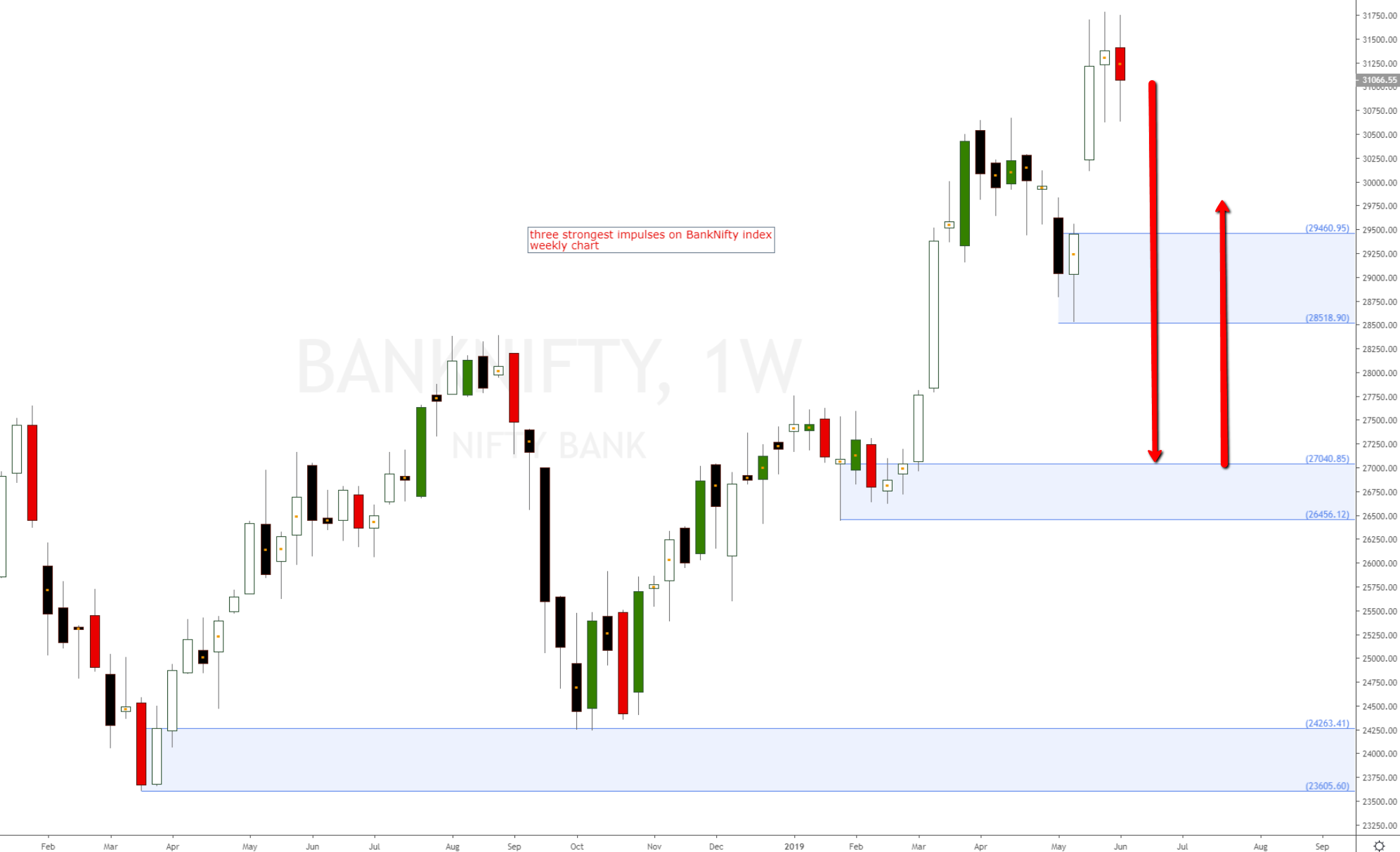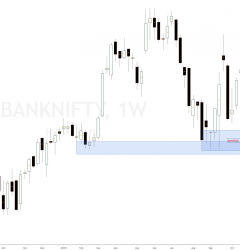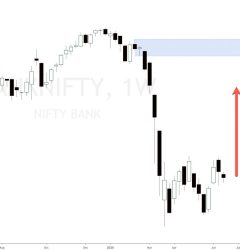10 Jun

I will explain the basics of what to look for to learn how to trade the BankNifty 50 Indian Index and locate turning points in the stock market.
Learn how to trade BankNifty Indian Index and locate turning points in the Indian NSE stock market
You could use many technical analysis trading strategies to learn how to trade BankNifty 50 and stocks within the BankNifty Indian index. In this video, we will explain what you should be looking for on a chart and the basic characteristics of candlesticks patterns that will help you locate turning points in the market.
It’s very important to trade this strong impulse in the context of a bigger-picture trend and avoid trading counter-trend scenarios. How can we buy BankNifty 50 futures index or Nifty 50-related stocks in an uptrend? First of all, you must look for impulses strong enough to create a series of wide candlestick bodies in the direction of the long-term trend. The chart attached shows three bullish impulses drawn on the BankNifty weekly timeframe, which means that every candlestick represents a week if time.
Higher probability stock trading versus lower probability stock trading
The upper weekly demand level on Bank Nifty is around 29460; even though it’s quite strong has a lower probability than the demand level at the bottom around 27040. In this technical analysis, we are only looking at the weekly timeframe. We must consider more than a single timeframe to place a trade and trade higher probability imbalances. This article only deals with the strength of the impulses. Both weekly demand levels are very strong. Still, if bigger timeframes are considered, the odds are way better at the lower weekly demand imbalance around 27040. If you want to learn the exact reasons why the upper demand imbalance is lower odds even though it’s pretty strong and it has an unfilled up, join our supply and demand trading course. You will learn all the rules that will teach you how to locate and trade high-probability imbalances.

The strength of the impulse is very important when trading stocks
By simply comparing the strength of those moves, you can locate potential turning points in the BankNifty Indian index and related BankNifty Indian stocks. Trading impulses against the trend is not the best strategy since you will be going against the long-term bias of the underlying asset or stock. How to buy the BankNifty index? Well, locate these impulses and do a top-down technical analysis before deciding to buy or sell at these impulses. A single timeframe technical analysis is not enough to make a trading decision.
Learning how to trade Indian stocks and the Nifty 50 futures Index looks easy, but it’s not; if it was easy, everyone could do it. If you are interested in how to trade the BankNifty index and NSE Indian Stocks, join our stocks trading course and our supply and demand trading community.
Some information about the Bank Nifty index
Bank Nifty represents the 12 most liquid and large capitalised stocks from the banking sector that trade on the National Stock Exchange (NSE). It provides investors and market intermediaries with a benchmark that captures the capital market performance of the Indian banking sector.
Trading Bank Nifty supply and demand imbalances are ideal for beginners and those with a full or half-time job, you won’t need to stay in front of the computer all day long trying to move Bank Nifty index price action with your mind.
As supply and demand traders, we do not need to pay attention to the news, fundamentals or any earnings reports. Once a big timeframe imbalance has gained control on the Bank Nifty Indian index, earnings do just the opposite and react strongly to those imbalances. Why is it that you see positive earnings and then the underlying stock drops like a rock, or a negative earnings announcement and the stock rallies like a rocket out of control? You are probably missing the fact that there are big imbalances in gaining control.
Unless you are doing very short term trading on Bank Nifty and scalping, you should not worry about fundamentals or earnings announcements.
You can use these imbalances to plan your trades on Bank Nifty options in lower timeframes. Trading is just waiting for the right trigger points and scenarios to present themselves, this game has got a name and it’s called the waiting game. We need to patiently wait for the correct scenarios on Bank Nifty Indian index and setups to happen and wait for the price to pullback or dip into the Bank Nifty Index price levels we want to trade, in our case, these price levels are made of supply and demand imbalances.
There are several ways of buying stocks. When trading stocks, you can buy shares of the underlying stock or use Bank Nifty options strategies to go long or short at these specific supply and demand levels on Bank Nifty index, long calls or long puts or spreads. You can even buy a CFD (contracts for difference) if you are in a country where it’s allowed.
Join our supply and demand online trading academy If you want to learn how to trade stocks using our supply and demand trading strategy.








